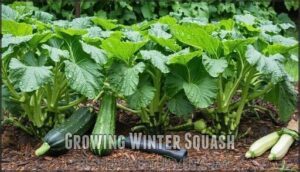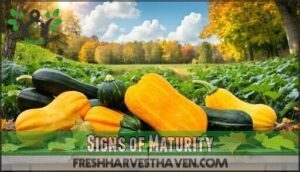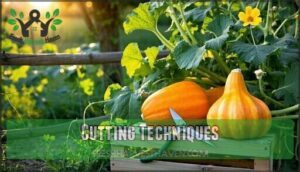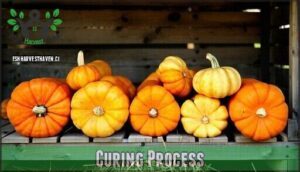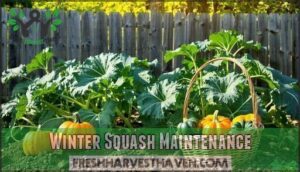This site is supported by our readers. We may earn a commission, at no cost to you, if you purchase through links.

Plant seeds ¾ inch deep in well-draining, nutrient-rich soil with plenty of space since these vines spread like gossipy neighbors.
You’ll need 90-120 frost-free days depending on variety, so count backwards from your first expected fall frost to nail your planting window. The secret lies in understanding your climate zone’s timing, proper soil prep techniques, and strategic variety selection that matches your growing season length.
Table Of Contents
- Key Takeaways
- Planting Winter Squash
- Growing Winter Squash
- Winter Squash Care Tips
- Harvesting Winter Squash
- Winter Squash Maintenance
- Frequently Asked Questions (FAQs)
- How do you grow winter squash?
- When to plant winter squash in Arizona?
- Why should you grow winter squash?
- Are winter squash hard to grow?
- When should you plant winter squash?
- How do you care for a winter squash plant?
- What month do you plant winter squash?
- What not to plant next to winter squash?
- How many winter squash do you get from one plant?
- How much space do winter squash plants need?
- Conclusion
Key Takeaways
- Time your planting perfectly – Wait until soil temperatures reach 65°F consistently after your last frost date, then count backwards 90-120 days from your first expected fall frost to determine your planting window.
- Prepare nutrient-rich soil properly – Test for pH levels between 6.0-6.8, work in 3-5% organic matter through compost, and ensure well-draining conditions to prevent seed rot and support healthy growth.
- Give plants adequate space – Plant seeds ¾ inch deep in hills spaced 4-6 feet apart for bush varieties or 8-10 feet for vining types, as these plants spread extensively and need room to thrive.
- Master the harvest and storage process – Look for hard rinds that resist fingernail pressure and dry stems, then cure at 80-85°F for 10-14 days before storing at 50-55°F with proper airflow for months of winter food storage.
Planting Winter Squash
Successful winter squash planting starts with selecting varieties that match your growing season and garden space.
You’ll need to prepare rich, well-draining soil and time your planting carefully for ideal germination and growth.
Choosing Right Variety
When selecting winter squash varieties, consider your garden’s space constraints and culinary goals.
Butternut squash offers exceptional storage life and sweet flavor profiles, while acorn squash provides nutty taste in compact spaces. Spaghetti squash delivers unique pasta-like texture.
Each winter squash variety brings its own superpower to your kitchen and garden space.
For more information on various types, explore the winter squash options available.
- Space-smart choices: Bush varieties like Butterbush butternut for small gardens, vining types like Blue Hubbard for sprawling spaces
- Storage champions: Butternut and kabocha types last months, while delicata varieties offer shorter but adequate storage life
- Regional favorites: Heat-tolerant Seminole pumpkin for Southeast gardens, cold-hardy Red Kuri for northern climates
Preparing Soil Conditions
After choosing your variety, soil preparation sets the foundation for success. Your winter squash thrives in fertile soil with proper drainage and balanced nutrients.
Test soil pH levels between 6.0-6.8 for ideal nutrient uptake. Check soil temperature reaches 65°F before planting to guarantee strong germination rates.
Proper fall soil preparation is essential for a healthy and productive garden.
| Soil Component | Target Range | Improvement Method |
|---|---|---|
| Organic Matter | 3-5% content | Compost addition |
| Soil pH | 6.0-6.8 | Lime or sulfur |
| Drainage | Well-draining soil | Sand/perlite mix |
Work compost into native soil several weeks before planting. Apply balanced fertilizer application at 2-3 pounds per 100 square feet for nutrient-rich growing conditions.
Sowing Seeds Directly
Direct sowing winter squash seeds requires precise soil temperature monitoring—wait until it reaches 60°F minimum, preferably 70°F.
Your sowing timing matters: plant 2-3 weeks after the last frost when soil’s consistently warm.
Follow this direct sowing approach:
- Seed depth: Plant seeds ½ to 1 inch deep in well-draining soil
- Hill planting: Space 3-5 winter squash seeds per mound, 4-6 feet apart
- Seed spacing: Thin to 2-3 strongest seedlings once they emerge
This planting guide guarantees high germination rates.
Starting Indoors Transplants
Starting squash seeds indoors extends your growing season, especially in cooler climates.
This seed starting method beats direct sowing when frost threatens your planting schedule.
Follow this indoor sowing approach:
- Seed Selection: Soak seeds overnight before transplanting squash varieties
- Timing: Start germination 2-4 weeks before last frost date
- Indoor Lighting: Provide 12-16 hours daily using grow lights
- Soil Temperature: Maintain 70-75°F for ideal seed starting conditions
- Transplant Timing: Harden seedlings outdoors gradually over one week
This controlled environment gives you healthier transplants and better harvest timing than direct methods.
Growing Winter Squash
Once you’ve planted your winter squash seedlings, proper growing techniques will determine whether you harvest a few small fruits or a bountiful crop that lasts through winter.
You’ll need to master four key areas: consistent watering that keeps soil moist but not waterlogged, strategic mulching to retain moisture and suppress weeds, selective vine pruning to focus energy on fruit development, and proactive pest management to protect your growing gourds.
Watering Techniques
Proper watering keeps your winter squash thriving throughout the growing season.
Soil moisture should stay consistently damp but never waterlogged—check water depth by inserting your finger two inches down.
Drip irrigation works best, delivering steady moisture directly to roots while keeping leaves dry.
Irrigation scheduling depends on rainfall and humidity; aim for deep, weekly sessions rather than frequent shallow drinks.
Mulching Strategies
Mulch your winter squash beds to create a protective barrier that works harder than you think. Organic mulch delivers triple benefits: moisture control, weed suppression, and thermal regulation for ideal growing conditions.
Apply these proven options around your plants:
- Straw or hay – Excellent soil retention and natural insulation
- Wood chips – Long-lasting moisture conservation with slow decomposition
- Compost – Adds valuable organic matter while maintaining well-draining soil
Layer mulch 3-4 inches thick, keeping it several inches away from stems to prevent rot and fungal issues. Using organic mulch products can enhance the overall growth of your winter squash.
Pruning Vines
Strategic pruning transforms sprawling squash vines into productive powerhouses. Start pruning techniques when plants reach 6-12 inches, targeting nonproducing vines and excess foliage.
Use sharp pruning tools for clean cuts during stem thinning. Focus vine training on main stems while practicing leaf removal below first flowers.
Master node management by snipping tips beyond last fruit on each vining type. This redirects energy toward mature size development rather than endless vine growth, maximizing your harvest potential.
Regular prune squash maintenance is vital for superior fruit production and plant health.
Managing Pests
After proper vine pruning, protecting your winter squash from squash bugs and other pests and diseases becomes your next priority.
These hungry invaders can destroy months of careful cultivation if left unchecked.
Here’s your battle plan for effective pest control:
- Hand-picking – Remove squash bugs and egg masses daily during morning inspections
- Pest traps – Use yellow sticky traps and cardboard shelters to catch cucumber beetles
- Organic sprays – Apply neem oil or insecticidal soap for natural pest control
- Biological control – Encourage beneficial insects like parasitic wasps and ground beetles
- Crop rotation – Move squash family plants to different garden areas each season
For squash vine borer infestations, carefully slice stems lengthwise to extract larvae, then mound soil over damaged areas for root regrowth.
Understanding effective control methods is essential for preventing squash bug infestations and protecting your winter squash crop.
Winter Squash Care Tips
Once your winter squash plants are established, proper care guarantees healthy growth and maximum yields.
You’ll need to maintain consistent feeding, monitor soil conditions, provide structural support, and troubleshoot common problems that can impact your harvest.
Fertilizing Schedule
Feeding winter squash correctly turns average harvests into abundant ones.
These heavy feeders demand consistent nutrition throughout their 75-110 day growing season to reach full potential.
Balanced Fertilizers work best with these three timing strategies:
- Pre-plant preparation – Work 3-4 pounds of 10-10-10 fertilizer per 100 square feet into soil, adding organic matter for sustained nutrient levels
- Early growth boost – Apply supplemental fertilizer when vines develop runners (35-45 days), side-dressing 6 inches from stems
- Flowering support – Switch to organic liquid fertilizer every 2 weeks once fruits appear, avoiding excess nitrogen that promotes leaves over squash
Understanding fertilizer types is essential for ideal winter squash growth.
Soil Testing guides your fertilizer timing decisions perfectly.
Soil PH Balance
Testing your soil pH creates the foundation for successful winter squash cultivation.
You’ll want pH levels between 6.0-6.5 for ideal nutrient balance.
Use soil testing kits to check current conditions.
If you discover acidic soil, add lime for alkaline correction.
Mix compost and organic matter into well-draining soil before applying fertilizers to achieve perfect growing conditions.
Supporting Vines
How can you maximize your garden space while keeping squash vines healthy?
Install sturdy trellis systems with wooden stakes or metal frames to guide vertical growth. Vine training requires gentle weekly guidance, wrapping tendrils around supports.
This space management approach reduces disease risk by improving airflow. Use climbing support structures spaced 6-8 feet apart for ideal vine management.
Proper garden supports make harvesting easier while creating room for companion planting underneath, transforming your garden design into a productive vertical showcase.
Common Growing Issues
Supporting healthy vines won’t prevent every problem you’ll encounter. Even well-maintained squash can develop issues requiring quick action and proper pest management.
Watch for these common problems:
- Powdery mildew creates white patches on leaves during humid weather—improve air circulation and apply fungicides.
- Squash vine borers cause sudden wilting when larvae tunnel through stems—check for entry holes and frass.
- Root rot from overwatering leads to plant collapse—ensure proper drainage to prevent fungal wilt.
- Nutrient deficiency shows as yellowing leaves—soil testing reveals imbalances needing correction.
Harvesting Winter Squash
You’ll know your winter squash is ready when the stem starts to dry and the rind becomes so hard that your fingernail can’t pierce it—no matter how determined you are.
The best part about timing your harvest right is that properly matured squash can last months in storage, turning your garden success into winter meals.
Signs of Maturity
Recognizing harvest time for winter squash requires checking several key indicators that signal peak maturity.
Your squash is ready when the rind resists fingernail pressure, the stem turns brown and dry, and colors reach their deepest, richest hue for that variety.
| Maturity Indicator | What to Check | Ready When |
|---|---|---|
| Skin Hardness | Press with fingernail | Rind resists indentation |
| Stem Dryness | Examine attachment point | Brown, dry, easily detached |
| Ripe Color | Visual inspection | Deep, vibrant variety color |
| Fruit Size | Compare to expected size | Full-sized for variety |
| Harvest Timing | Count days from planting | 75-110 days depending on type |
Sound testing works too—tap the squash and listen for a hollow thud, indicating proper ripening and reduced moisture content inside.
Cutting Techniques
Proper cutting techniques guarantee your winter squash stays fresh during storage.
Use sharp pruning tools to make clean cuts, leaving 2-3 inches of stem attached to prevent rot and extend shelf life.
- Harvest cutting: Cut during dry weather conditions for ideal handling
- Stem removal: Never pull fruit; always use pruning shears for vine cutting
- Fruit trimming: Clean tools between plants to prevent disease spread
Curing Process
Successfully curing your winter squash transforms good harvests into great ones. The curing process requires 10-14 days in controlled conditions to achieve proper skin hardening and moisture control.
Place freshly harvested squash in a warm location with temperatures between 80-85°F and humidity around 80%. Good airflow prevents mold development during this critical harvest management phase.
| Curing Factor | Optimal Range |
|---|---|
| Temperature | 80-85°F |
| Humidity | 80% |
| Duration | 10-14 days |
| Air Circulation | Continuous |
Test readiness by pressing your fingernail against the rind—properly cured skin won’t puncture easily. These drying methods guarantee your squash develops the tough exterior needed for extended storage life while enhancing natural flavors through concentrated sugars, which is a result of the curing process and leads to great harvests with good airflow.
Storage Methods
The ultimate test for winter squash lies in proper storage after curing.
Store your harvest at 50-55°F with 60-70% humidity in cool storage areas like root cellars or dry rooms.
Here’s your storage success formula:
- Space squash individually on shelves or pallets to prevent rot spreading
- Monitor weekly for soft spots, removing damaged fruits immediately
- Avoid refrigeration – freezing methods work better for preservation
- Maintain airflow around each fruit for ideal longterm storage
Different varieties offer varying storage lifespans.
Proper storage techniques involve understanding food safety guidelines to keep your harvest fresh.
Winter Squash Maintenance
You’ve invested months growing your winter squash, but proper maintenance determines whether you’ll enjoy a bountiful harvest or watch your crop fail to common problems.
From preventing devastating vine borers to saving seeds for next season, consistent care through the growing season protects your investment and guarantees maximum yields.
Pest Control Methods
Crop rotation keeps squash bugs and squash vine borers guessing—move your plants yearly to break pest cycles.
Deploy organic sprays like neem oil against small nymphs, while insect barriers protect young plants.
Pest traps and beneficial biological control agents like ground beetles handle the heavy lifting.
Hand-picking eggs stops infestations before they start.
Disease Prevention
Shield your winter squash from diseases before they strike. Disease-resistant varieties offer your strongest defense against common threats like powdery mildew, bacterial wilt, and mosaic virus.
Essential disease prevention strategies:
- Rotate crops – Move cucurbits to different plots every 2-3 years
- Use drip irrigation – Keep leaves dry to prevent fungal control issues
- Space plants properly – Improve airflow to reduce bacterial management problems
- Remove plant debris – Clear infected material immediately after harvest
- Apply organic remedies – Neem oil and copper sprays provide virus prevention when applied early
Saving Seeds
Save seeds from fully mature winter squash for best germination rates. Select open-pollinated Cucurbita varieties rather than hybrid seeds, which won’t breed true.
After seed collection, rinse away pulp and ferment in water for 2-3 days. This natural seed cleaning process removes inhibitors and improves viability.
Spread cleaned seeds on screens for thorough seed drying—proper moisture removal prevents mold during seed storage. Store dried seeds in cool, dry conditions for maximum longevity, ensuring proper handling to maintain seed quality.
Troubleshooting Problems
When Squash Pests attack or Nutrient Deficiency strikes, quick action saves your harvest. Address Root Rot from overwatering and Frost Damage immediately.
Common troubleshooting steps:
- Inspect leaves weekly for pests and diseases – early detection prevents major losses
- Test soil drainage to prevent Soil Erosion and waterlogged conditions
- Choose disease-resistant varieties next season for better outcomes
Use manual pest removal and sticky traps for immediate control. Maintain cross-pollination awareness by protecting beneficial insects while targeting harmful ones. Regular winter tree care practices can also inform strategies for protecting squash plants from similar issues.
Frequently Asked Questions (FAQs)
How do you grow winter squash?
Plant winter squash after soil reaches 65°F, spacing seeds 1 inch deep in hills 4-6 feet apart.
Provide full sun, rich well-draining soil, and consistent moisture throughout the 75-110 day growing season.
When to plant winter squash in Arizona?
Unlike temperate climates where spring planting rules, Arizona’s desert heat demands a different schedule.
You’ll plant winter squash in late August through September, taking advantage of cooler autumn temperatures for establishment before winter harvest.
Why should you grow winter squash?
Growing winter squash gives you long-lasting, nutritious food storage that’ll keep for months after harvest.
You’ll enjoy sweet, versatile flesh packed with vitamins while saving money on grocery bills throughout winter.
Are winter squash hard to grow?
Want stress-free gardening?
Winter squash isn’t difficult to grow—they’re actually quite forgiving once established.
You’ll need warm soil, full sun, and plenty of space for their sprawling vines to flourish successfully.
When should you plant winter squash?
You’ll want to plant winter squash seeds after your last frost date when soil temperatures reach at least 65°F, typically between late May and early June in most regions.
How do you care for a winter squash plant?
Water consistently, maintaining soil moisture without waterlogging.
Apply balanced fertilizer monthly during growing season.
Mulch around plants to retain moisture and suppress weeds.
Monitor for squash bugs and vine borers regularly.
What month do you plant winter squash?
Timing your winter squash planting correctly means the difference between harvest success and frost-killed dreams.
You’ll plant winter squash in late May through early June when soil temperatures reach 65°F consistently.
What not to plant next to winter squash?
Avoid planting winter squash near cucumbers, melons, or other cucurbits—they’ll compete for nutrients and attract similar pests.
Skip fennel and aromatic herbs too, as they can stunt growth and reduce yields substantially.
How many winter squash do you get from one plant?
Each winter squash plant typically produces 3-5 fruits, though vining varieties like butternut can yield 6-8 per plant. Bush types produce fewer but concentrate energy into larger, higher-quality squash.
How much space do winter squash plants need?
Plant spacing depends on variety, but you’ll need 4-6 feet between bush types and 8-10 feet for vining varieties.
Some pumpkins sprawl up to 15 feet, so give them room to roam!
Conclusion
Congratulations—you’ve officially joined the ranks of gardeners who think planting winter squash involves more planning than a NASA mission.
Your winter squash planting guide journey doesn’t end when you toss seeds in dirt and hope for the best.
You’ll master timing, soil prep, pest management, and storage techniques that transform ordinary gardeners into squash whisperers.
From selecting varieties to curing harvested fruits, you’ve got the tools to grow winter squash that’ll impress neighbors and survive months in storage.
- https://www.paharvestofthemonth.org/documents/gardening/growing-winter-squash.pdf
- http://www.gardening.cornell.edu/homegardening/scene11f1.html
- https://hubpages.com/living/forum/269993/what-is-the-best-time-of-the-year-to-plant-pumpkins-and-squash
- https://joegardener.com/how-grow-winter-squash/
- https://aggie-horticulture.tamu.edu/wp-content/uploads/sites/10/2013/09/EHT-041.pdf





